How Accessibility can be integrated Meaningfully and Sustainably into Business Operations
Accessibility is not just a legal obligation but a strategic business advantage. The disability community is an economic power counting over 1.3 billion people globally with $13 trillion in disposable income (including friends, family, and allies), and over $500 billion in annual spending in the U.S. alone.
Following a panel discussion organized by SFDBA during Small Business Week 2025 and bringing together leaders committed to building an inclusive world, their message is clear: (1) Businesses that prioritize accessibility position themselves for growth, loyalty, and long-term success. (2) Small, intentional changes in accessibility can yield significant returns, especially for agile businesses.
Speakers and Panelists from Left to Right: Andre LeMont Wilson, Small Business Program Manager at Ability Now; Michael Hingson, NY Times Bestselling Author, Podcaster and International Lecturer; Joshua Klipp, Attorney, Founder & Certified Access Specialist at Made Welcome; Peter DeHaas, Founder and Executive Director of the San Francisco Disability Business Alliance; Eli Gelardin, Director, Director of San Francisco Office on Disability and Accessibility; Kiran Kaja, Principal Product Manager at Amazon Worldwide Stores Accessibility.
This blog summarizes their insights and gives a holistic view of how accessibility can be integrated meaningfully and sustainably into business operations.
Accessibility as a Strategic Imperative
Not just compliance: Accessibility goes beyond legal requirements (ADA) and represents a moral, business, and economic opportunity.
Business growth: Inclusive practices build customer loyalty, improve usability for all, and open businesses to a broader, multigenerational market.
Common Misconceptions & Fears
Misconceptions: Many believe accessibility is expensive, complex, or only for people with permanent disabilities.
Reality: Simple, intentional changes (e.g., clear signage, accessible restrooms, large print menus) are often inexpensive and widely beneficial.
Cost-Effective Implementation
Think universal inclusive design: Accessibility can benefit all. It serves people with permanent, temporary, and situational impairments (Automatic doors help wheelchair users and parents with strollers; screen readers benefit blind users and multitasking professionals alike.)
Low-cost wins: Reorienting a door, adjusting shelf heights, providing accessible counters and tables, displaying signage with large prints and using plain language are all impactful.
Build it in from the start: It's far cheaper to design for accessibility up front than to retrofit later. Take advantage of new technologies including AI tools to be more inclusive.
Legal and Practical Framework
ADA is the floor, not the ceiling: It encourages “good faith” efforts and rewards businesses that try, even if they don’t get it perfect.
Spirit of the law: A truly accessible space is welcoming and user-centered, not just technically compliant. Local nonprofits, state agencies, and resource centers offer practical support and staffing solutions.
City and federal programs: Grants (e.g., San Francisco’s $10K barrier removal grant) and tax credits (e.g., Disabled Access Credit, Work Opportunity Tax Credit) are available to help fund accessibility improvements.
Sustained Accessibility Practice
Evaluate and evolve: Treat accessibility like any core business function—track progress, solicit feedback, and adjust regularly.
Start small, grow over time: Begin with checklists and basic upgrades, then build toward best practices. Ask people with disabilities directly for input, then act on it.
Cultural Shift
Challenge prejudice: Disability is not a lack of ability. Everyone has varying abilities and needs accommodations in different ways.
Normalize accessibility: Fear and ignorance are common barriers. Education, exposure, and empathy break them down.

